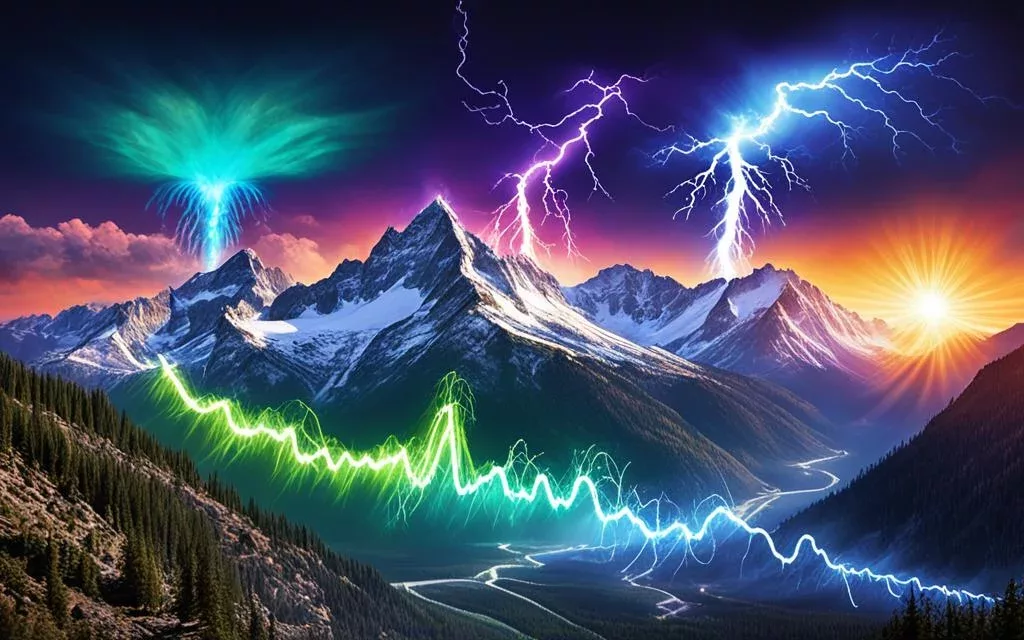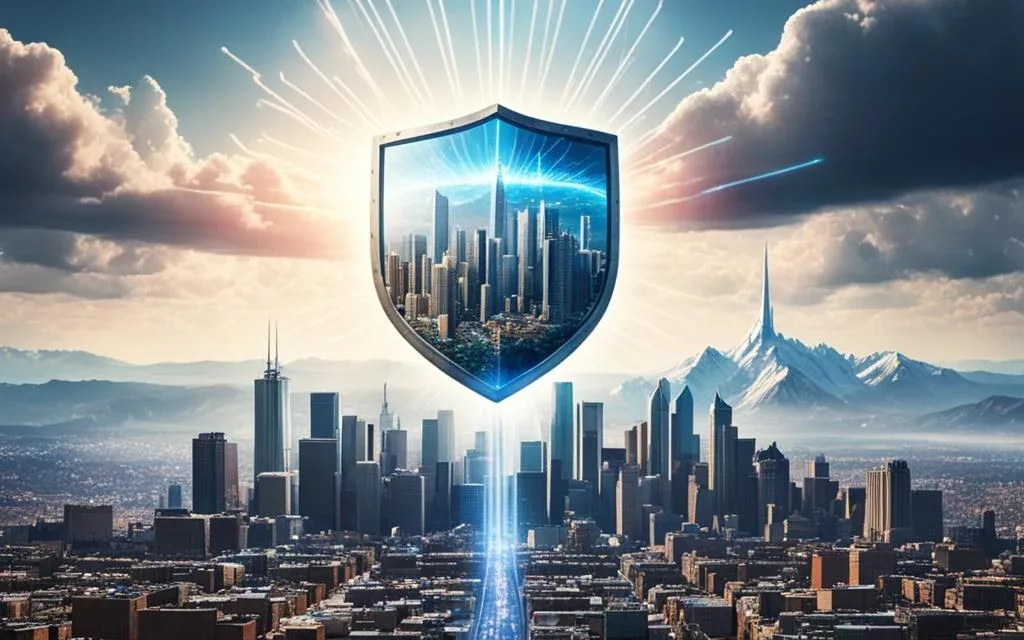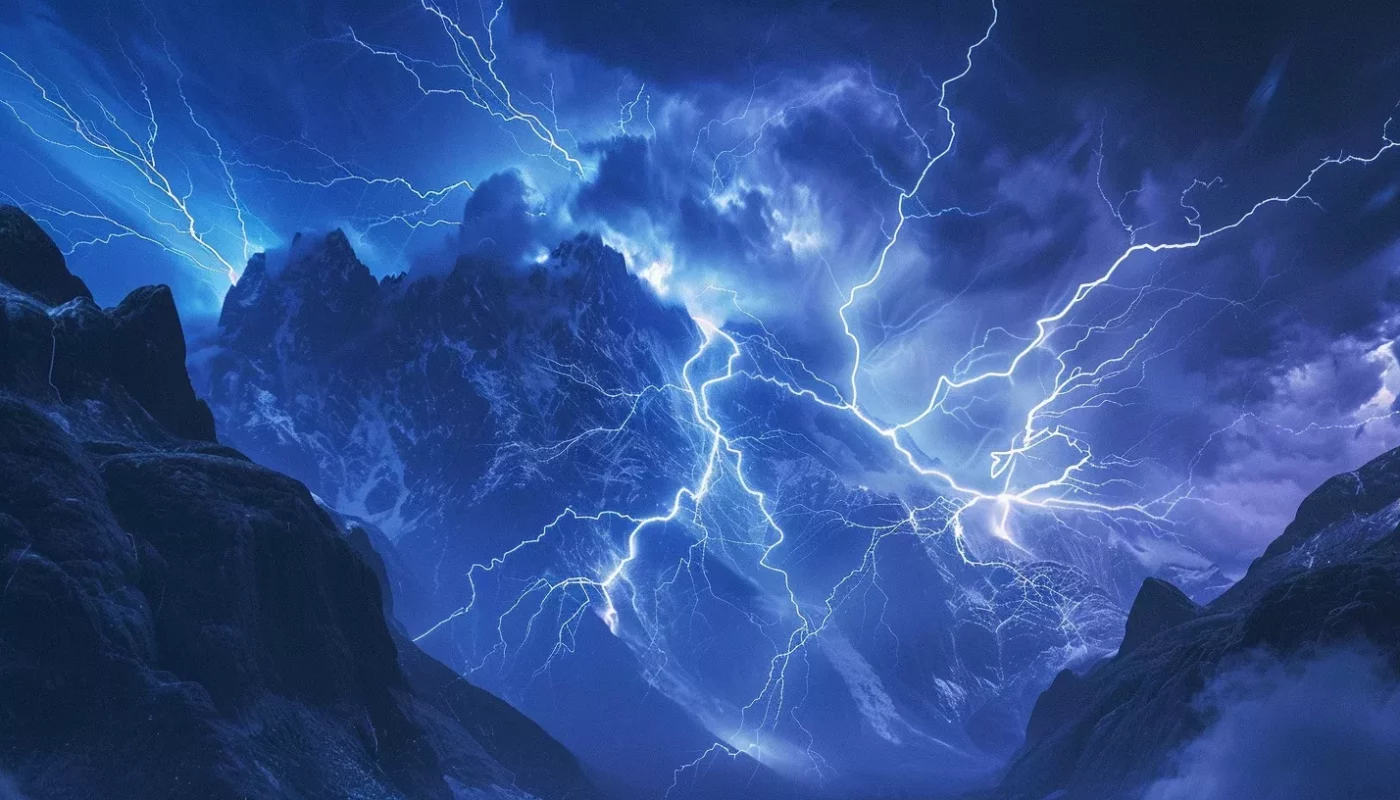Did you know millions of transient luminous events (TLEs) light up the upper atmosphere every year? These include the amazing red sprites. They shine above severe thunderstorms, linked to lightning below. Lasting just moments, they fill the sky with bright colors and complex patterns. Let’s dive into the fascinating world of TLEs and learn about red sprites.
What are Red Sprites?
Red sprites are an amazing type of transient luminous event (TLE) that happen above storms. These bright red flashes can look like vertical columns or tendrils. They are thought to come from the positive lightning between the cloud and the ground.
These light flashes can be up to 50-90 kilometers high and often appear together. They are usually seen with thunderstorms. Sometimes, they happen during high-altitude activities above storms, which can lead to accidents.
As a natural phenomenon, red sprites make storm systems more wondrous. They inspire researchers and fans. Now, let’s dive into what makes these light flashes so fascinating.
Characteristics of Red Sprites
Red sprites have unique features that catch our interest and challenge researchers. Here are some key traits:
- Color: Their bright red color is why we call them “red sprites,” which makes them stand out from other TLEs.
- Shapes: They can look like vertical columns or tendrils, which is pretty interesting to see in the night sky.
- Height: They go up to 50-90 kilometers high, adding to their mystery.
- Clustered Occurrence: Red sprites often show up in groups, making a beautiful scene above storms.
Conservation of Red Sprites
There aren’t special efforts just for red sprites, but it’s important to study and keep them safe. By protecting storm environments, we can keep watching and admiring these incredible light shows.
Other Types of Transient Luminous Events
Red sprites are fascinating, but the sky has more wonders to show. In the upper atmosphere, phenomena like blue jets, gigantic jets, elves, sprite halos, and pixies light up the sky. There are even rare sights known as trolls.
Blue jets are amazing blue discharges that start from thunderstorm clouds and shoot up about 50 kilometers. They make the stormy sky a spectacular scene. Their beauty adds to the electric wonders that storms bring.
Gigantic jets are like sprites but they go even higher, up to 90 kilometers. They form with strong thunderstorms and lightning. Seeing them is truly unforgettable.
Elves are quick flashes of light that come from electromagnetic events. They appear around 100 kilometers high. Named after their scientific acronym, elves create wave patterns in the sky.
Sprite halos are rings of light that appear around sprites. They result from light scattering in the atmosphere. These halos make sprites even more mesmerizing.
Ghost phenomena are still a mystery, showing up as cloudy visions in the sky. Their nature is less known, making them quite intriguing. Scientists are trying to learn more about them.
Pixies show up as small, faint lights near other phenomena like sprites or blue jets. They look magical and add to the wonder of the sky’s light shows.
Trolls are lesser-known and not well understood. They appear as odd patches of light. Though not common, they add variety to the electrical events above.
Comparison of Different Transient Luminous Events
| TLE Type | Distinctive Features | Altitude (km) |
|---|---|---|
| Blue Jets | Blue-colored discharges | Approximately 50 |
| Gigantic Jets | Similar to sprites, higher altitudes | Around 90 |
| Elves | Emissions of light and low-frequency perturbations | Approximately 100 |
| Sprite Halos | Circular rings of light accompanying sprites | Varies |
| Ghost Phenomena | Diffused, cloudy, or hazy appearances | Varies |
| Pixies | Clusters of small, faint lights | Varies |
| Trolls | Patches of light with peculiar shapes | Varies |
These different types of transient luminous events create dazzling light shows above storms. As studies go on, we learn more about these high sky mysteries.
Characteristics of Transient Luminous Events
Transient luminous events (TLEs) are exciting electrical phenomena happening high above us. They grab the attention of both scientists and enthusiasts. It’s important to know their features, like how long they last and how we can record them, to learn more about these rare occurrences.
TLEs have durations that vary widely. Some are over in a blink, lasting less than a millisecond, while others can last more than 2 seconds. This range makes TLEs even more intriguing and a key focus for scientific studies.
The first video of a TLE was found by accident in 1989. A researcher left a camera on overnight and found two unusual, finger-like images on the film the next day. This discovery was a breakthrough, giving us the first visual proof of TLEs.
Thanks to better technology, we can now record TLEs more systematically. Different kinds of cameras have caught these amazing sights on video. We’ve collected tens of thousands of these recordings, helping scientists learn more about TLEs.
Experts think millions of TLEs happen worldwide every year, thanks to satellite observations. Even though we can’t usually see them without special equipment, satellites show us that TLEs are common in our atmosphere.
Continued research into TLEs is revealing more about how they form and their importance. By studying these stunning electrical events, scientists aim to better understand our atmosphere and its response to powerful thunderstorms.
| TLE Characteristics | Duration | Video Recording |
|---|---|---|
| Brief Flashes | Less than a millisecond | Recorded by optical systems |
| Extended Displays | More than 2 seconds | Accidental and deliberate video capture |
| Global Occurrence | Several million events per year | Recorded by satellites |
History of Transient Luminous Events
In the early 20th century, Scottish physicist C.T.R. Wilson had a theory. He believed in upper-atmospheric lightning, but it was not documented until 1989. That year, people first saw sprites, a type of TLE, captured on film by accident. Cameras left on overnight showed strange images that sparked curiosity.
Then, in the 1990s, “red sprites” and “blue jets” became well-known. This happened after videos of them were shared widely. Everyone, from scientists to the public, was intrigued by these mysterious and beautiful events. This interest led to more research and a better understanding of TLEs.
Since then, our knowledge of TLEs has grown a lot. Advances in technology have played a big part in this. They’ve helped scientists study these amazing events in the sky in great detail.
Notable Milestones in TLE Research:
- 1920s: Scottish physicist C.T.R. Wilson predicts the existence of upper-atmospheric lightning and transient luminous events.
- 1989: The first direct visual evidence of TLEs, specifically sprites, is accidentally captured on film.
- 1990s: The terms “red sprites” and “blue jets” gain popularity after the widespread circulation of video footage showcasing these events.
- Ongoing: Advances in technology and continuous research provide a deeper understanding of TLE characteristics and occurrence.
Studying TLEs has taught us much about lightning above the clouds. It helps us understand Earth’s atmosphere better. We learn about the electromagnetic activities happening far above us.

| Year | Significant Milestone |
|---|---|
| 1920s | Scottish physicist C.T.R. Wilson predicts the existence of upper-atmospheric lightning and transient luminous events. |
| 1989 | The first direct visual evidence of TLEs, specifically sprites, is accidentally captured on film. |
| 1990s | The terms “red sprites” and “blue jets” gain popularity after the widespread circulation of video footage showcasing these events. |
| Ongoing | Advances in technology and continuous research provide a deeper understanding of TLE characteristics and occurrence. |
Jets: Blue Jets and Gigantic Jets
Upper-atmospheric lightning shows us two amazing sights: blue jets and gigantic jets. Both are stunning examples of nature’s electrical wonders.
Blue jets are thought to start from regular lightning within a thundercloud. They move upwards, showing off a deep blue light. This light reaches high into the sky, fascinating those who see it.
Gigantic jets act differently from blue jets. They start within the cloud, between different charged areas. Unlike blue jets, they move up slowly but reach farther into the atmosphere. Their beautiful light show can brighten the night sky.
Studying blue and gigantic jets tells us a lot about lightning high above us. Researchers learn how these events start and grow by observing them.
Comparing Blue Jets and Gigantic Jets
Let’s see how blue jets and gigantic jets are different:
| Blue Jets | Gigantic Jets | |
|---|---|---|
| Initiation | Normal lightning discharges | Intracloud flashes |
| Height | Lower altitudes | Higher altitudes |
| Propagation Rate | Faster | Slower |
From this comparison, it’s clear that blue jets and gigantic jets differ in several ways. Knowing these differences helps us understand more about lightning high up in the sky.
People who study blue and gigantic jets find them very intriguing. Their research helps us appreciate the wonders beyond our daily life.
Observations of Jets
Scientists around the world are fascinated by blue jets and gigantic jets. These rare lightning events in the upper atmosphere were first filmed from the Space Shuttle in 1989 over Australia. Today, high-speed cameras help us study these phenomena during thunderstorms.
Blue jets spread out and vanish around 25-30 miles up, lasting a brief moment. They shine blue because they emit blue and near-ultraviolet light. Gigantic jets, however, reach higher and might start differently.
Photos and videos give us key insights into how these lightning events form. They let researchers look at their structure and how they move. This helps us learn how thunderstorms interact with the upper atmosphere.
The study of these jets helps us understand the sky’s electrical wonders. These images have amazed both scientists and people everywhere. They highlight the stunning beauty of these quick events.
Jet studies keep attracting attention. Every time we record a jet, we learn more about our changing atmosphere. These efforts show our desire to know more about the mysteries above us.
Protection Against High-Altitude Electromagnetic Pulse (HEMP)
HEMP comes from nuclear blasts high above the earth. These pulses can mess up communication, power, and command systems. It’s very important to guard against their damaging effects with the right tools and methods.
To keep things safe from HEMP, using electromagnetic shields is a big deal. Materials like copper and aluminum block harmful electromagnetic waves. This helps protect sensitive gear and systems from damage.
Another key defense is HEMP specific filtering. It stops surges caused by HEMP pulses from hurting sensitive equipment. By using filters and shields together, we can greatly improve protection.
Surge protectors are crucial for preventing damage from HEMP. Devices like MOV and TVS diodes defend electrical systems from harmful currents. Having good grounding is also key. It makes sure harmful energy is safely moved away.
Isolating electronic equipment helps lessen HEMP’s bad effects too. Electrical isolation and special waveguides keep sensitive devices running smoothly. This keeps them safe and working longer.
It’s super important to follow expert advice when setting up HEMP protection. These tips help organizations protect their tech from powerful HEMP blasts. Using many types of protection like shielding, filtering, and grounding helps a lot. This way, the damage from HEMP can be greatly reduced.
Example HEMP Protection Techniques:
| Technique | Description |
|---|---|
| Electromagnetic Shielding | Utilizes materials like copper and aluminum to provide high levels of electromagnetic wave attenuation and prevent direct absorption effects of HEMP. |
| HEMP Special Filtering | Prevents or arrests induction surges caused by the HEMP pulse from coupling into sensitive equipment. |
| Surge Protection | Uses technologies like MOV and TVS diodes to prevent damage to electronics and electrical systems from induced currents during HEMP events. |
| Grounding | Establishes a stable equipotential ground and provides a surge current sink, safeguarding systems from excess energy during HEMP events. |
| Isolation | Reduces the induction of HEMP-produced currents through electrical isolation and the use of beyond cutoff waveguides. |
Using these methods and sticking to best practices improves our defenses. Investing in strong protection helps keep our vital tech safe from HEMP’s harmful effects. With good planning, communication systems, and power grids stay secure.
Electromagnetic Shielding and HEMP Filtering
To protect from High-Altitude Electromagnetic Pulses (HEMP), electromagnetic shielding and HEMP filtering are key. They are essential for keeping sensitive equipment safe. They also limit damage from HEMP events.
The Power of Electromagnetic Shielding
Electromagnetic shielding blocks HEMP’s direct hit. It uses materials like copper and aluminum, which are great at stopping electromagnetic waves. These materials help keep electronic gear safe.
The shielding creates a barrier. This barrier stops electromagnetic waves from reaching and harming devices. This way, it acts as a strong defense against HEMP.
Preventing Induction Surges with HEMP Filtering
HEMP filtering stops induction surges that HEMP pulses can cause. It works differently from shielding. Instead of stopping waves, it handles surges caused by HEMP.
HEMP filters use special parts to block harmful currents. By managing these surges, they protect equipment from HEMP’s high-energy pulses. This keeps critical gear safe.
Together with good grounding, these technologies offer solid HEMP protection. They help keep systems working safely, even when faced with electromagnetic threats.

Incorporating Conservation
Using these technologies also aids conservation. They protect devices from HEMP, reducing the need for repairs. This lowers electronic waste and helps the environment.
Measures like electromagnetic shielding and HEMP filtering keep infrastructure safe. They also support sustainable practices for a greener future.
Surge Protection and Additional Techniques for HEMP Mitigation
Protecting electronics from high-altitude electromagnetic pulses (HEMP) needs surge protection. Metal-oxide-varistors (MOV) and transient voltage suppression (TVS) diodes are key. They keep sensitive equipment safe from voltage spikes.
But, surge protection isn’t enough for full HEMP safety. Good grounding is also key. It makes a stable ground and provides a path for surge currents. This minimizes the risk of damage to electrical systems.
Isolation methods also help by limiting HEMP-induced currents. Electrical isolation separates critical parts from the main power. Besides, structures known as beyond cutoff waveguides block harmful electromagnetic waves. This protects sensitive electronics.
In summary, combining surge protection, grounding, and isolation helps against HEMP threats. These steps improve the resilience of electronics. They help to keep them working even during HEMP events.
Below is a table summarizing the key attributes of surge protection, grounding, and isolation techniques:
| Technique | Key Attributes |
|---|---|
| Surge Protection | – Safeguards electronics and electrical systems – Prevents damage from voltage spikes – Utilizes MOVs and TVS diodes |
| Grounding | – Establishes a stable equipotential ground – Provides a surge current sink – Minimizes the risk of current overload |
| Isolation | – Reduces induction of HEMP-produced currents – Utilizes electrical isolation techniques – Incorporates beyond cutoff waveguides |
Using surge protection, grounding, and isolation helps against HEMP. Still, each system or place may need specific ways to stay safe. It’s smart to talk with experts to get the best protection.
Conclusion
Red Sprites and other transient luminous events (TLEs) are amazing. They happen high above intense thunderstorms. These natural light shows have caught people’s attention for years.
But we need to watch out for the dangers they bring. High-altitude electromagnetic pulses (HEMP) can mess up communications and wreck electrical grids.
To keep our tech safe, we use methods like electromagnetic shielding. Also, HEMP filtering and surge protection are key. Grounding and isolating systems help protect our electrical grids even more.
Studying Red Sprites and TLEs helps us learn more about the sky. They’re linked to blue jets and ELVES, other cool sky events. This research gives us clues about the weather and our planet.
We should focus on safe research and taking care of these events. That way, we can learn more while keeping the natural beauty intact.




